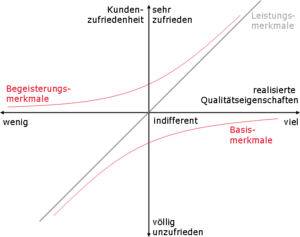Series: Successfully introducing lean administration (1): Understand the customer better with the Kano model
Series: Successfully introducing lean administration (1): Understand the customer better with the Kano model
The central goal of lean management is to increase the added value for the customer. In the indirect areas of the company, we usually have internal customers, a department or person within the company, often called a ‘process customer’. In all activities, the first step is to determine what this customer, the purchaser of a service, actually needs. If you apply it consistently, you can often save a lot of work, so to speak ‘lean for lazy people’.
A classic example are the key figures or reports that were requested at some point and that are diligently created even though the client no longer exists. In order to avoid this, a precise order clarification before the start is definitely recommended in order to clarify the actual needs of the customer. It can be about data and information, but also formats in which something is delivered. We recently had an example that involved list entries that took a lot of effort to create but were used by the recipient in a completely different place.
A very helpful tool for a better understanding of customers is the Kano model, which originally comes from quality management. For this purpose, the customer requirements are classified according to the following characteristics – here with an example from the travel booking:
- Basic features are self-evident properties that only become apparent when they are not met.
- Performance characteristics: these the customer expects and creates customer satisfaction, depending on the extent of fulfillment
- Delightful featuresare not expected by the customer, they surprise and contribute significantly to satisfaction and customer loyalty.
Even an everyday process such as “booking a business trip” can be analyzed more precisely with the model, as the example shows:
- Basic features: timely booking of trains, flights, rental cars, hotels
- Features: convenient distance between the hotel and the place of work, short waiting times when changing means of transport, choice of the fastest connection, consideration of special requests (choice of seats on the plane…etc.)
- Enthusiasm: Automatic reminder with clear travel information 24 hours before departure; for trips abroad, country information with a small phrasebook
, Source: https://de.wikipedia.org/w/index.php?curid=3539699
The nice thing about the model is that you can see very quickly where the effort is worthwhile and where you can significantly increase customer satisfaction with little resources. A systematic application of this model brings us one step closer to our goal of increasing value for our customers.
Source: Lean Administration Step by Step, Volume 1






